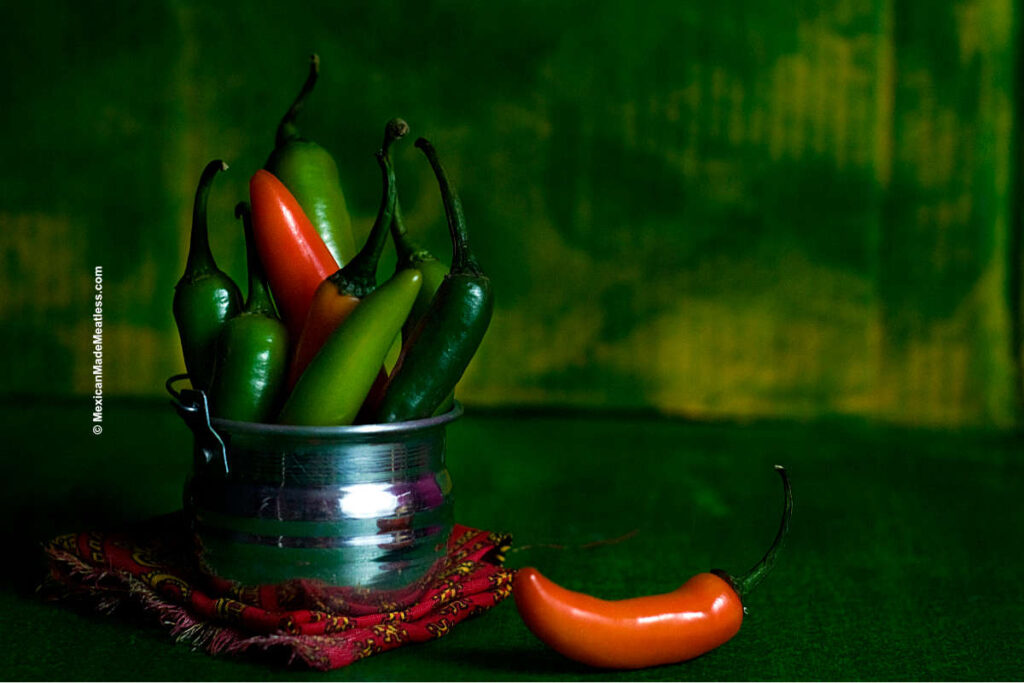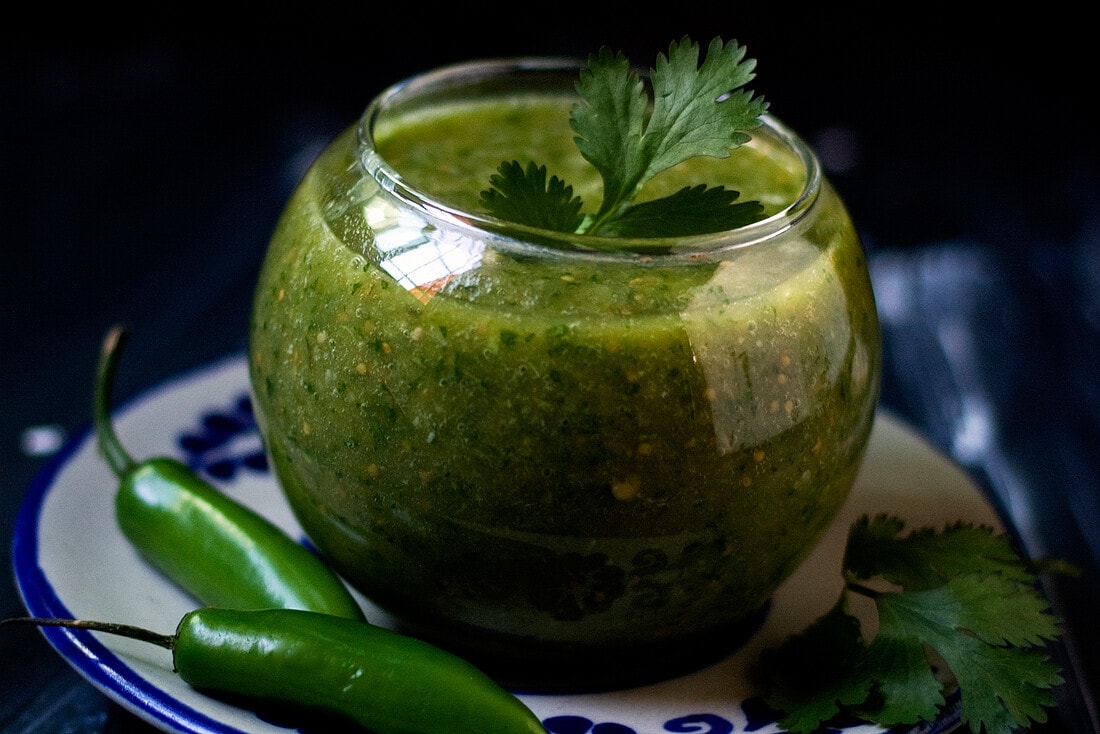The Surprising Health Benefits of Eating Spicy Food
If you’re a fan of hot sauce, spicy salsas, jalapeño and cayenne pepper you’re going to be amazed with all the surprising health benefits of eating spicy food. So if you’ve wondered if eating spicy food is good or bad for your health, read this article!

Spicy Food
Did you know that spicy food also comes with a wide range of health benefits? Read on to find the surprising health benefits of eating spicy foods.
Spicy food has been a staple of many cuisines all around the world for many centuries.
From the fiery heat of salsas, pollo and camarones a la diabla, tinga tostadas, enchiladas to many more Mexican foods; spicy dishes have been enjoyed by many adventurous eaters for their delicious bold flavors and satisfying heat.

Samples of Spicy Foods
There is a wide range of spicy or hot foods, it’s not just chile peppers. Below are some examples.
- Chile Peppers: Everything from milder jalapenos to ultra spicy habaneros, Thai bird chili and the Worlds spiciest chili pepper the Carolina Reaper.
- Black Pepper: The heat is different than chiles, but it’s still spicy.
- Hot Sauces
- Wasabi and Other Horseradish
- Red Pepper Flakes: These are made from a mix of mild dried chili peppers and spicier red peppers.
- Ginger: Not a pepper but spicy in it’s own way.
- Salsa
- Mustard
- Pozole, Birria, Enchiladas, Frijoles Charros, Menudo
- Curries
- Hot Wings

Is Spicy Food Healthy?
There is a common misconception that eating spicy foods is unhealthy.
Those of us that like a little (or a big) kick of heat in our food will sometime or another have heard some of the following statements.
- Spicy food is bad for your stomach and esophagus lining.
- Spicy food will ruin your teeth and taste buds.
- Spicy food will always cause gastrointestinal problems.
For those with pre-existing digestive health issues, like stomach ulcers, spicy food is not recommended.
The rest of us, sure when our bodies aren’t used to the heat or perhaps we added a bit too much spicy heat to the dish, some of us might experience unpleasant side-effects.
But they are temporary and often times we can both prevent or tone down their severity.
Of course when it comes to eating spicy food, the most important thing is making sure you don’t have pre-existing digestive system issue. Additionally it’s good to know our personal heat tolerances or limits.
I’d now like to share some facts about the health benefits of adding spicy flavors to our meals. But first, let’s begin with understanding what makes chiles spicy.

What Makes Chiles Spicy?
Glistening skin, curvaceous, and colors that beg to be touched, smelled and tasted; chile peppers are among nature’s prettiest creations.
They range in color, shapes, and in heat levels too.
Some will leave a pleasant tingle on the tongue, while others will make you feel like flames are shooting out of your mouth and steam is blasting out your nose and ears just like a teakettle.
What Gives Chile Peppers Their Heat?
The common misconception is that the seeds are where the heat is at, not entirely so.
It is actually a chemical called capsaicin that is responsible for the burning sensation we experience when eating hot peppers.
Capsaicin is found in the chili pepper’s membranes and to a lesser extent across the inside of the pod.
The white pith inside of each pepper pod is called the placenta, and this is the hottest part of the chile.
Though the seeds are attached to the placenta, they do not produce capsaicin. It’s only because they are attached to that white pith that they end up being spicy, and therefore tricking a lot of people into believing that they are responsible for the heat.
Capsaicin is found in nearly all members of the capsicum family, in other words, all chile peppers. The only exception to this are bell peppers, which contain none.

Did You Know Not All Species Can Taste Spicy?
Not all Earth species feel the effects of capsaicin or fiery heat of a chile pepper. So depending on whether you like the heat or not, you can consider humans lucky or unlucky.
When we eat a chili pepper, the capsaicin binds to pain receptors in our mouths that are responsible for pain.
Capsaicin tricks these pain receptors into thinking that something hot (as in temperature) was introduced to the body, which in turn sends signals to the brain to try to cool down the mouth.
We begin to sweat, our noses run, sometimes we cough, our mouth and eyes water, all in the body’s attempt to flush out the unwanted (capsaicin) substance.
Depending on how spicy the pepper is, our bodies will expel the burning sensation in a matter of minutes or it can take hours. It all depends on how spicy and where on the Scoville Scale the chili falls onto.
While eating chile peppers has many great benefits for our bodies, capsaicin in it’s purest form can be very unpleasant.
Pharmaceutical Chemist Lloyd Matheson of the Univeristy of Iowa stated “Pure capsaicin is so powerful that chemists who handle the crystalline powder must work in a filtered “tox room” in full body protection. The suit has a closed hood to prevent inhaling the powder. It’s not toxic, but you wish you were dead if you inhale it.”
While most of use will not be handling (or inhaling) pure capsaicin, its smart to play it safe and wear gloves when handling peppers. Of course it is also important to work ourselves up from milder chiles to the spicier ones, in order to give our bodies time to adapt to the heat.

Health Benefits of Eating Spicy Food
By adding a little bit of spice to our diets can boost our health and wellbeing.
Of course if you have any risk factors or have digestive tract issues it’s very important to talk to your physician first.
(Please notice that the following does not apply to eating large amounts of the world’s spiciest peppers.)
Spicy Food Makes Your Mouth, Belly and Mind Happy
The first and most obvious health benefit of eating spicy food and adding spice to our foods are all the new flavors.
From spicy ginger, garlic, and horseradish to an array of chile peppers, they all add a different taste for our taste buds to discover.
These new flavors enhance a dish, affect the taste buds differently and it can truly be an amazing culinary experience.
Additionally spicy foods are believed to “…boost production of serotonin…” and we all know that this in turn makes our minds feel happy and keep depression at bay.
Most importantly, we all know that sitting down to eat good food always makes people happy.
Weight Loss
Study after study has proven that adding spicy food to our diets increases our metabolism, this in turn helps us burn more energy or calories.
Additionally, spicy food can help you feel fuller faster (it’s an appetite suppressant), which can lead to eating less overall.
According to WebMD “…capsaicin has been show to boost metabolism as well as suppress appetite, at least slightly…Piperine (found in dried black pepper) may prevent new fat cells from forming…”
Of course this is all within reason, eating too many calories even after consuming spicy food will not help in weight loss. The most important thing when it comes to weight loss is to follow a healthy balanced diet.
Spicy Food Can Improve Heart Health
Spicy food doesn’t just taste good – it can also be good for your heart.
Eating chili peppers has also been proven to reduce bad cholesterol and the formation of blood clots. This benefit leads to a lower risk of pulmonary embolism and heart attacks.
The natural antioxidant properties of spicy foods help keep our hearts healthy.
Studies have shown that capsaicin can help to lower blood pressure and improve blood flow, this in turn strengthens our cardiovascular system and reduces the risk of heart disease.
The capsaicin helps open up your blood vessels and so it helps to increase your blood flow.
Additionally, the antioxidants found in spicy foods can help to reduce inflammation, another risk factor for heart disease.
Anti-Inflammatory Benefits and Pain Relief
Capsaicin has natural anti-inflammatory qualities that people with arthritis and heart problems can greatly benefit from.
Apparently, capsaicin is an ingredient commonly used in topical creams and gels that are used as pain reliever caused by inflammation.
I have on several occasions witnessed the amazing effects that spicy food has in fighting arthritic pain. I’ve seen people go from severe joint pain to feeling nearly pain free after consuming spicy foods.
Spicy Food Can Boost Your Immune System
Many spicy foods contain Vitamin C, which is know to help boost the immune system. These compounds have antibacterial properties which can help to fight off harmful bacteria and viruses, keeping the immune system healthy and strong.
Spicy Food Can Improve Your Digestive Tract
The main concern for many is that spicy food will damage your stomach lining.
But unless you all ready have a severe gastric conditions like irritable bowel syndrome, ulcerative colitis, inflammatory bowel disease, Crohn’s disease, you shouldn’t need to worry too much. (If you are unsure consult your physician first.)
That spicy, burning sensation can actually be good for your digestive tract.
Spicy food can help to stimulate the production of digestive juices and enzymes, aiding in digestion and preventing gastrointestinal issues like constipation and bloating.
Studies have shown again and again that the substance that gives chilles their heat, capsaicin, in fact repairs and not damages the stomach lining.
Capsaicin can even help heal the damaged caused by anti-inflammatory drugs (like aspirin) that do in fact cause ulcers and destroy the stomach lining. Additionally “Chili peppers…not only do they not cause ulcers, they can help prevent them by killing bacteria you may have ingested, while stimulating the cells lining the stomach to secrete protective buffering juices.”
Cancer Fighting Properties
There is no evidence that eating spicy food in moderation causes cancer. In fact the Journal of The National Cancer Institute (Oxford Journals), wrote a very interesting article titled “Capsaicin in Hot Chili Peppers Makes Tumor Cells Commit Suicide.” Which talks about cancer research and it’s ability to inhibit the growth of cancer cells.
Other spicy foods (such as curry) not only contain capsaicin from the chilies used, but also other cancer fighting ingredients. Specifically turmeric, which contains curcumin which has been proven to have cancer fighting qualities.
Helps Regulate Body Temperature
When we eat spicy food our body temperature rises. “…If you are living in a hot climate, the increase in body temperature can make you feel cooler by diminishing the difference between you and the surrounding air and by inducing sweating, which cools the body when the perspiration evaporates.”
I live in the Tropics and can personally tell you that this is true, spicy food is a must for fighting off the heat.
Now that we know that spicy food raises our body temperatures, we can safely deduct that this greatly helps during the cold winter months.
Eases Congestion
Having a stuffy noses can be caused by seasonal allergies, a cold or flu, the dry winter air or the lack of humidity caused by the use of heating units.
But you don’t always need to reach for the medicine cabinet.
Eating something spicy helps break up the congestion by making your nose run.
You will instantly be able to blow your nose and feel relief — even if only temporary. So try eating a spicy curry, salsa, horseradish, ginger, wasabi, spicy mustard or your favorite chile pepper.

FAQ About Spicy Foods
Can Spicy Food be Bad For You?
While spicy food can have many health benefits, for some it could be problematic. Those with a sensitive stomach or with acid reflux, may find spicy foods exacerbate their symptoms. It’s important to pay attention to how your body reacts when you eat spicy foods.
What are Some Good Spicy Foods to Try?
There are so many delicious spicy foods to choose from – and not just in Mexican food. Here’s some popular options: different chili peppers, salsas, hot sauces, curries, and kimchi.
Can I Increase My Spicy Food Heat Tolerance
First of all, always pay attention to your body when you eat spicy foods. Slowly you can work your way up to hotter peppers and dishes.

In conclusion, adding a little bit of spice to your diet can do wonders for your health. Yes, there are many surprising health benefits of eating spicy food. From aiding in weight loss to improving heart health, spicy food has a wide range of benefits that shouldn’t be overlooked.
So why not try incorporating a little bit of heat into your next meal? Below are some delicious Mexican spicy food options.
- Easy Mexican Cucumber Recipe (Snack Made with Chili and Lime)
- Mexican Mangonada Recipe (Chamoyada)
- Dulces Enchilados or Chamoy Candy
- Pambazos Recipe
- Pozole Rojo
- Pozole Verde
- Chicharron en Salsa Verde
- Tacos de Papa Dorados (Potato Tacos Recipe)
- Tinga | Tinga Tostadas
- Fiery Habaneros Toreados
- Mango Pico de Gallo
- Spicy Fire Roasted Habanero Peppers Salsa
- Tomato Chile de Arbol Salsa
Nancy Lopez is a food blogger and author of the cookbook Mexican Tamales Made Meatless. Born in Mexico, raised in the US, and currently living in Southern Mexico, she has followed a meatless diet for almost 10 years. It is her passion and mission to share all she has learned about vegan Mexican cooking and vegetarian Mexican recipes. Mexican Made Meatless is a blog dedicated to preserving the authentic flavors of Mexican cuisine just without the meat. It’s a place to celebrate Mexican culture and all it’s delightfully delicious traditional foods. Read more…







Wow all my life I thought the heat was in the seeds. I had only heard about how spicy food can hurt yur stomach. good to know that isn’t the case.
It’s a common misconception, in fact I used to think the same thing.